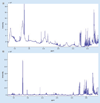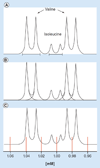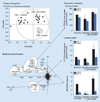Translational metabolomics in cancer research
- PMID: 26329905
- PMCID: PMC4718447
- DOI: 10.2217/bmm.15.52
Translational metabolomics in cancer research
Abstract
Over the last decade there has been a bottleneck in the introduction of new validated cancer metabolic biomarkers into clinical practice. Unfortunately, there are no biomarkers with adequate sensitivity for the early detection of cancer, and there remain a reliance on cancer antigens for monitoring treatment. The need for new diagnostics has led to the exploration of untargeted metabolomics for discovery of early biomarkers of specific cancers and targeted metabolomics to elucidate mechanistic aspects of tumor progression. The successful translation of such strategies to the treatment of cancer would allow earlier intervention to improve survival. We have reviewed the methodology that is being used to achieve these goals together with recent advances in implementing translational metabolomics in cancer.
Keywords: NMR spectroscopy; cancer; cancer diagnosis; diagnostic biomarkers; lipidomics; liquid chromatography-mass spectrometry; prognostic biomarkers; untargeted metabolomics targeted metabolomics.
Conflict of interest statement
The authors have no other relevant affiliations or financial involvement with any organization or entity with a financial interest in or financial conflict with the subject matter or materials discussed in the manuscript apart from those disclosed.
No writing assistance was utilized in the production of this manuscript.
Figures






Similar articles
-
Metabolomics of cancer.Methods Mol Biol. 2009;520:273-95. doi: 10.1007/978-1-60327-811-9_20. Methods Mol Biol. 2009. PMID: 19381962
-
Metabolomics toward personalized medicine.Mass Spectrom Rev. 2019 May;38(3):221-238. doi: 10.1002/mas.21548. Epub 2017 Oct 26. Mass Spectrom Rev. 2019. PMID: 29073341 Review.
-
Applications of mass spectrometry to metabolomics and metabonomics: detection of biomarkers of aging and of age-related diseases.Mass Spectrom Rev. 2012 Jan-Feb;31(1):70-95. doi: 10.1002/mas.20338. Epub 2011 Apr 28. Mass Spectrom Rev. 2012. PMID: 21538458 Review.
-
Oncometabolomics in cancer research.Expert Rev Proteomics. 2013 Aug;10(4):325-36. doi: 10.1586/14789450.2013.828947. Expert Rev Proteomics. 2013. PMID: 23992416 Review.
-
Lipidomics, Biomarkers, and Schizophrenia: A Current Perspective.Adv Exp Med Biol. 2017;965:265-290. doi: 10.1007/978-3-319-47656-8_11. Adv Exp Med Biol. 2017. PMID: 28132184 Review.
Cited by
-
Presence of human breast cancer xenograft changes the diurnal profile of amino acids in mice.Sci Rep. 2022 Jan 19;12(1):1008. doi: 10.1038/s41598-022-04994-6. Sci Rep. 2022. PMID: 35046467 Free PMC article.
-
A Review of Pulmonary Toxicity of Electronic Cigarettes in the Context of Smoking: A Focus on Inflammation.Cancer Epidemiol Biomarkers Prev. 2017 Aug;26(8):1175-1191. doi: 10.1158/1055-9965.EPI-17-0358. Epub 2017 Jun 22. Cancer Epidemiol Biomarkers Prev. 2017. PMID: 28642230 Free PMC article. Review.
-
Translational Metabolomics: Current Challenges and Future Opportunities.Metabolites. 2019 Jun 6;9(6):108. doi: 10.3390/metabo9060108. Metabolites. 2019. PMID: 31174372 Free PMC article.
-
Company profile: BluePen Biomarkers LLC – integrated biomarker solutions.Future Sci OA. 2016 Jun 9;2(2):FSO124. doi: 10.4155/fsoa-2016-0031. eCollection 2016 Jun. Future Sci OA. 2016. PMID: 28031971 Free PMC article.
-
Challenges in Metabolomics-Based Tests, Biomarkers Revealed by Metabolomic Analysis, and the Promise of the Application of Metabolomics in Precision Medicine.Int J Mol Sci. 2022 May 6;23(9):5213. doi: 10.3390/ijms23095213. Int J Mol Sci. 2022. PMID: 35563604 Free PMC article. Review.
References
-
- O’Connell TM. Recent advances in metabolomics in oncology. Bioanalysis. 2012;4(4):431–451. - PubMed
-
- Blair IA. Eliminating Bottlenecks for Efficient Bioanalysis: Practices and Applications in Drug Discovery and Development. London, UK: Future Science Group; 2015. Bioanalysis supporting disease biomarker discovery and validation; pp. 162–181.
-
- Forcisi S, Moritz F, Kanawati B, Tziotis D, Lehmann R, Schmitt-Kopplin P. Liquid chromatography-mass spectrometry in metabolomics research: mass analyzers in ultra high pressure liquid chromatography coupling. J. Chromatogr. A. 2013;1292:51–65. - PubMed
Publication types
MeSH terms
Grants and funding
LinkOut - more resources
Full Text Sources
Other Literature Sources
